Do you want to display the most recent comments first in WordPress?
By default, WordPress displays older comments first. However, you may want to change this so that the most recent comments appear first.
In this article, we will show you how to easily rearrange comments in WordPress and display the most recent comments first.

Why Display the Most Recent Comments First in WordPress?
Showing the latest comments first in WordPress is good for getting more comments and encouraging lively discussions.
By default, WordPress puts the oldest comments at the top, but this might not help spark new conversations. When you put the newest comments first, it motivates visitors to join ongoing discussions, boosting user engagement on your WordPress blog.
Plus, highlighting the latest comments freshens your site’s look and makes it more appealing, potentially increasing pageviews and reducing the bounce rate in WordPress.
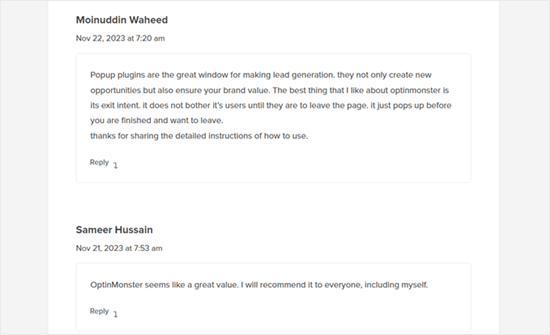
That being said, let’s see how you can easily display the most recent comments first in WordPress. Simply use the quick links below to jump to the method you want to use:
Method 1: Display Newer Comments First in WordPress Settings (No Plugin)
The easiest way to rearrange your comments is by heading over to Settings » Discussion in your WordPress dashboard.
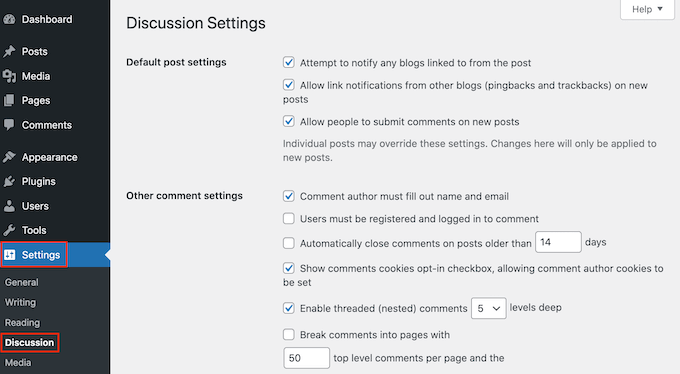
In the other ‘Other comment settings’ section, find ‘Comments should be displayed with…’
This is set to ‘older comments at the top of each page’ by default, but you can open this dropdown and choose ‘newer’ instead.
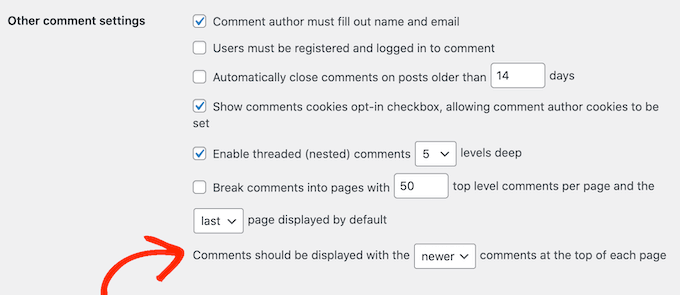
Once you have done that, just scroll to the bottom of the page and click on ‘Save Changes’ to store your settings.
Now if you visit your WordPress blog, then you will see the newest comments first.
For more information about using the WordPress discussion settings, check out our beginner’s guide to moderate WordPress comments.
Method 2: Manually Set Comment Display Order in WordPress (Code Method)
The first method is the easiest, but there are some cases where the WordPress settings won’t work.
For example, you might have created a custom WordPress theme that overrides the default WordPress settings.
In that case, you can show the newest comments first using code.
Often, tutorials will tell you to add custom code snippets to your theme’s functions.php file. However, we don’t recommend this method because a small mistake in your code could cause a number of common WordPress errors or even break your site completely.
That’s why we recommend using WPCode. It is the easiest and safest way to add code snippets in WordPress without having to edit any core WordPress files.
The first thing you need to do is install and activate the free WPCode plugin on your website. For more details, please see our step-by-step guide on how to install a WordPress plugin.
Upon activation, you need to go to Code Snippets » Add Snippet in your WordPress dashboard.
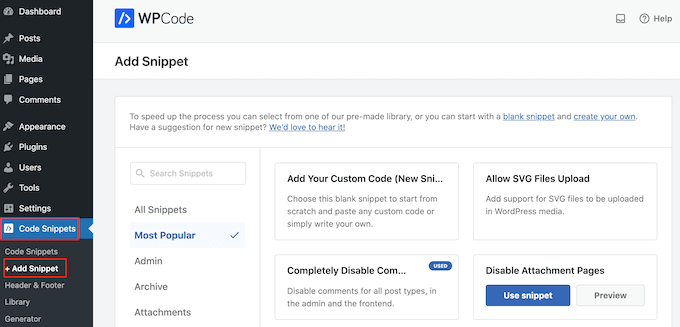
Here, you will see all the different ready-made snippets that you can add to your site.
Since we want to add our own snippet, simply hover your mouse over ‘Add Your Custom Code’ and then click ‘Use snippet.’
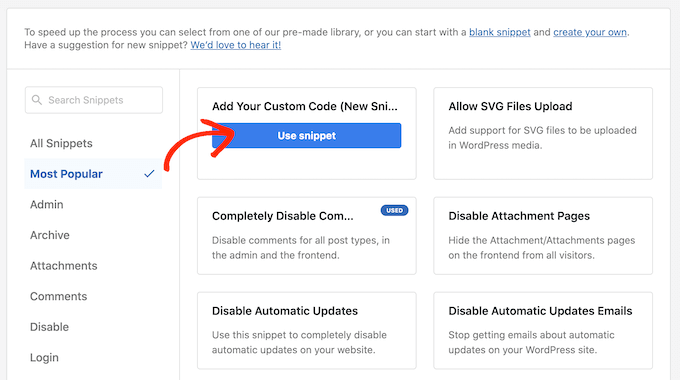
To start, just enter a title for the custom snippet. This can be anything that helps you identify the code snippet in your WordPress dashboard.
After that, open the ‘Code Type’ dropdown and select ‘PHP Snippet.’
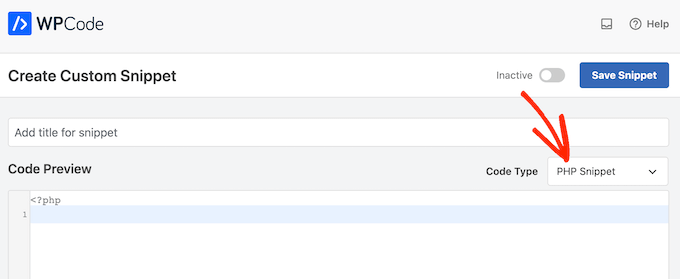
Now, you can go ahead and paste the following snippet into the code editor:
function wpb_reverse_comments($comments) {
// Check comment order
$comment_order = get_option('comment_order');
// if comment order is default then change it.
if ( $comment_order == 'asc' ) {
return array_reverse($comments);
}
}
add_filter ('comments_array', 'wpb_reverse_comments');
This code starts by checking your WordPress settings. If the comment order is set to oldest first, then the code snippet will override this so that the newest comments appear first.
After that, scroll to the ‘Insertion’ section. If it isn’t already selected, then choose the ‘Auto Insert’ method so that the snippet will be used across your entire WordPress website.
After that, open the ‘Location’ dropdown and select ‘Run Everywhere.’
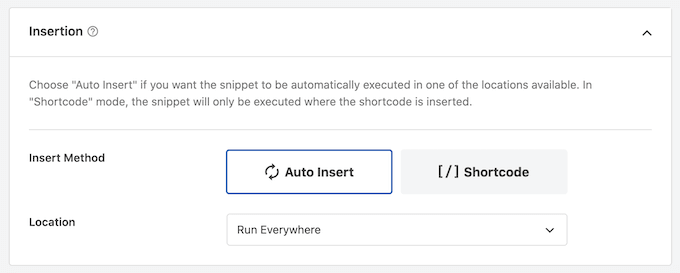
With that done, scroll to the top of the screen and click on the ‘Inactive’ toggle so it changes to ‘Active.’
Finally, click on ‘Save snippet.’
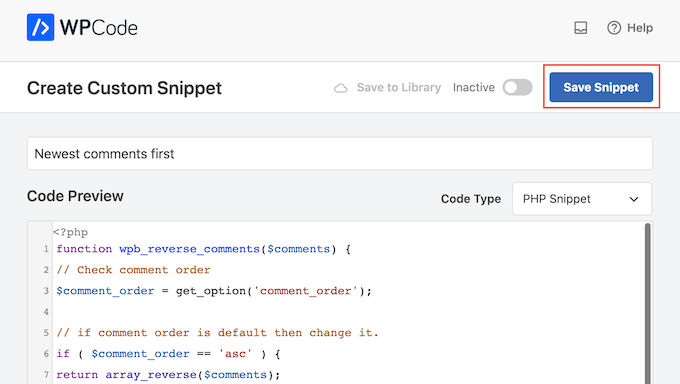
To make the snippet live on your website, go ahead and click on the ‘Inactive’ slider so it turns to ‘Active.’
Finally, click on ‘Update.’
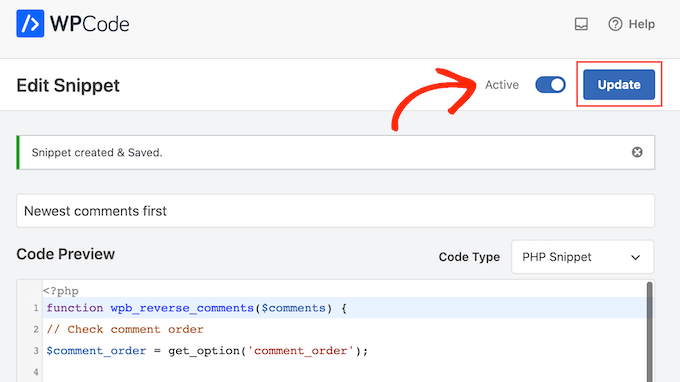
Now, if you visit your WordPress website, then you will see the newest comments at the top of the comment section.
Just be aware that the code will override your WordPress settings. If you want to switch back to showing the oldest comments first, then you will need to disable the code snippet.
Simply go to Code Snippets » Code Snippets. Here, find the comment snippet and click on its toggle to turn it from active (blue) to inactive (grey).
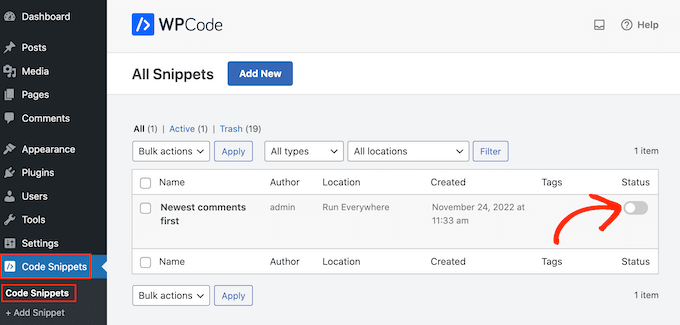
Bonus Tip: Boost Comment Engagement With Thrive Comments
Displaying the most recent comments in WordPress is just one way to boost your user engagement. Another method is to use a comment plugin like Thrive Comments.
Out of all the comment plugins we’ve tried, Thrive Comments has some of the most comprehensive features to improve your comment section.
For example, you can use the comment conversion feature to redirect commenters to a specific action after they leave a comment. This can be a custom thank you page, a related post, or an opt-in form with Thrive Leads.
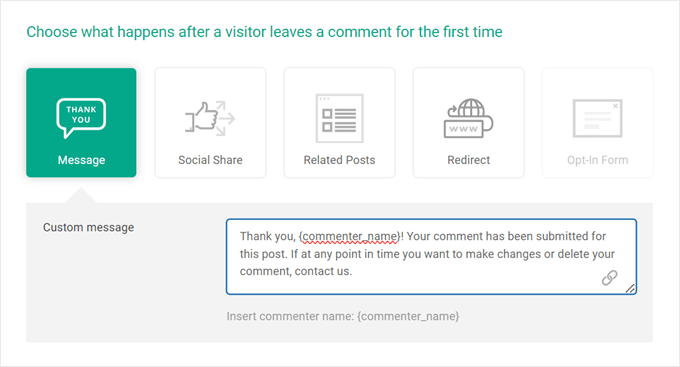
As a result, you can make your commenters stay on your website for longer.
For more information about this comment plugin, check out our in-depth review of the Thrive Themes Suite.
We hope this article helped you learn how to display the most recent comments in WordPress. You may also want to see our guide on how to allow user registration on your WordPress website or our expert picks for the best WordPress membership plugins.
If you liked this article, then please subscribe to our YouTube Channel for WordPress video tutorials. You can also find us on Twitter and Facebook.





Syed Balkhi says
Hey WPBeginner readers,
Did you know you can win exciting prizes by commenting on WPBeginner?
Every month, our top blog commenters will win HUGE rewards, including premium WordPress plugin licenses and cash prizes.
You can get more details about the contest from here.
Start sharing your thoughts below to stand a chance to win!
Lisa says
I don’t have the “other comments” option. What do I need to do to make it available?
WPBeginner Support says
Are you on WordPress.com?
Admin
M Smith says
Thanks so much! Had this fixed in a few seconds!
WPBeginner Support says
You’re welcome
Admin
Jo Smith says
Wow this was really helpful! Thank you.
ZYnth RObinson says
thank you! this is the only thing that worked for me!!
Andrei says
Thank you for this tip: $comments = array_reverse($comments);
I tried the admin option of showing newest comments at the top and it didn’t work, but your code worked. Thank you!
rexcollin91 says
I think this is one of the most important info for me. And i’m glad reading your article. But should remark on some general things, The website style is wonderful, the articles is really excellent
jackmoores says
Hey I discovered this web site to be actually interesting! Bookmarked!
tonchavez17 says
I am typically to running a blog and i really respect your content. The article has actually peaks my interest. I’m going to bookmark your web site and maintain checking for new information.I am typically to running a blog and i really respect your content. The article has actually peaks my interest. I’m going to bookmark your web site and maintain checking for new information.
shainatim says
I prefer method 2, it is easier than codes. I hate codes coz I am not good at it. Thanks for the plugin.
Jim Hutchinson says
@Grace T In your Dashboard, drop down the Plugins list and click Add New. In there you will see a link on top to Upload. Click that and then the Browse button to locate the ZIP file you downloaded. Then click Install Now.
You may be prompted for your FTP login details. If you are, enter it and click the Proceed button. The next page will show 2 links: Activate Plugin and Return to Plugins page. Click Activate Plugin to start using it now.
Grace T says
I downloaded the plugin, but I’m really not great with technology, so how do you activate it? This sounds like a stupid question, but I really need help!
Udegbunam Chukwudi says
@Jim Hutchinson: That discussion settings stuff doesn’t work at all.
@Editorial Staff: It would have been better if you just said replace
with.I had to go to the wordpress forum to find this solution.
Jim Hutchinson says
A plugin is not needed for this. Just go into the Discussion Settings and select how you want the comments to show, older or newer.
“Comments should be displayed with the [older][newer] comments at the top of each page”
Grace T says
Oh, I just realised you’re right! Thankyou!
Chijo says
I see that this plugin has not been updated since 2008 so I’m wary about using it.
Also, I do see the setting in Discussion and have set my comments to display Newest at the top, but that doesn’t seem to work.
Anyone have any thoughts?
thanks
Editorial Staff says
Use the default option in the Discussion area.
Stefan Pinto says
Will it work with Disqus?
Kevin says
I am having a custom WordPress theme developed by someone from elance.com and I would like to know whether or not I’ll be able to install plugins such as Simple Reverse Comments because my theme is custom. Can you shed light on this? Maybe I should cut my losses and go with something like the Thesis theme which is more cookie-cutter? Thank you for your blog, it has been very helpful to me.
Editorial Staff says
You should be able to install this plugin in your custom theme.
Admin